~ Sayeed Ahmed
Oh! The Sufi Princess You are the sweetest martyr That we all madly admire You are the icon of integrity Dwelling in our hearts for eternity You are now the radiant star In this glorious universe.
("A Tribute to the Illuminated Woman of World War II," by Irfanulla Shariff)
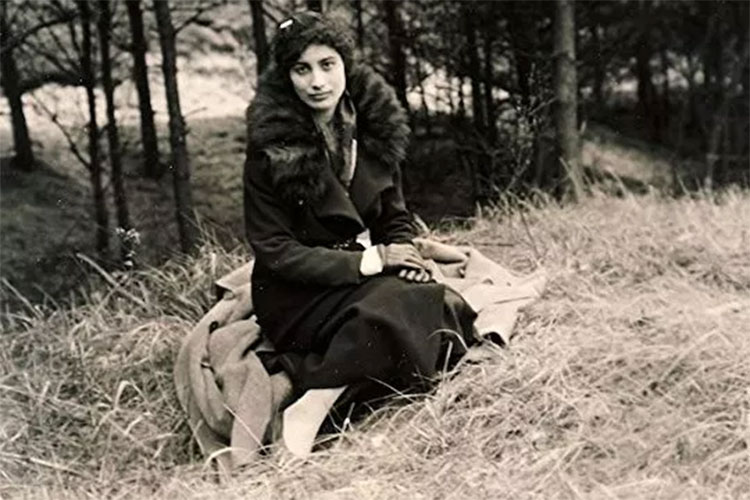
Photograph: Internet Princess Noor Inayat Khan
"Liberté"
That was her last word as an SS officer shot at the back of her head at Dachau concentration camp, about 25 km northwest of Munich. It was September 14, 1944. She was Princess Noor Inayat Khan, an agent of the British Special Operations Executive (SOE).
Noor was one of four women kneeling against a mound. One by one, the officer executed all four. The spy inspired by Sufi idealism was defiant until the end, never defeated despite the extreme brutality the Nazi regime inflicted on her.
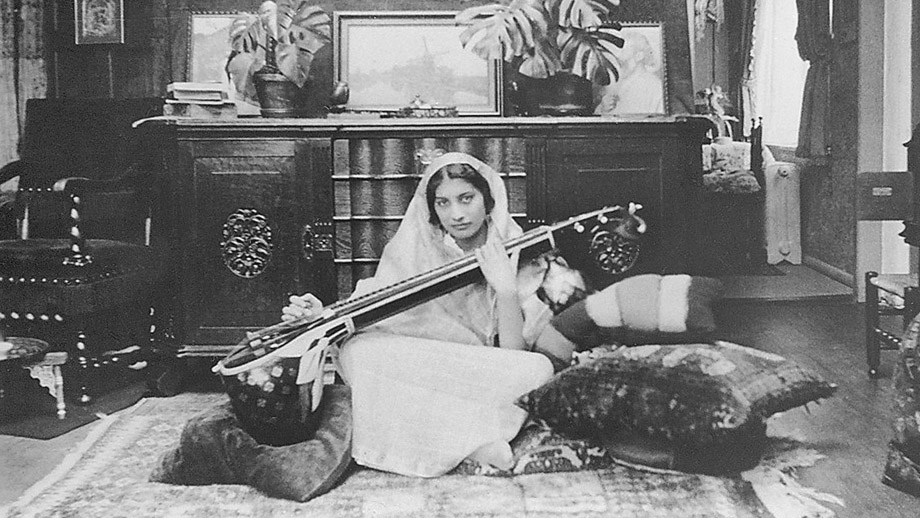 ]
]
The Arrival of the Princess
On the night of June 16, 1943, a single-engine Lysander aircraft landed at an undisclosed location inside Nazi-occupied France. Three passengers descended from the plane. One of these passengers was Noor, codenamed Madeleine. She was a great-great-great-granddaughter of Tipu Sultan, the legendary Muslim ruler of Mysore, India. Shy and gentle in temperament, Madeleine was to work as the radio operator for the Prosper network of SOE France. She would be the crucial link between the French Resistance Groups and the War Office in London.
The Sufi
Noor was born in Saint Petersburg, Russia, in 1914, to her Indian father, Rehmat Khan Pathan Inayat Khan, a preacher of Sufism, and American mother, Ora Ray Baker. Khan, known as Hazrat Inayat Khan to his followers, was the founder of the Sufi Order religion and a descendant of the royal house of Tipu Sultan of the Kingdom of Mysore. Khan met Ora during a trip to New York in 1910. The family later settled in Paris, where Khan's teachings attracted many followers. Their home was called the "Fazal Manzil," or the House of Blessings. Fazal Manzil was the family home and the place where Hazrat Khan conducted his teachings with talks, meetings, and prayers. Followers came from all over Europe to listen to Hazrat and participate in his prayer sessions in search of the faith they had lost after WWI.
Noor spent her formative years amid all this activity, feeling herself to be a part of something larger than herself, part of the larger community regardless of nationality, religion, or ethnicity. At the center of all was the Sufi teachings of her father. With such surroundings, Sufism became the anchor in her life, forming her entire personality.
While Hazrat Khan's international headquarters of his Sufi Movement were in Geneva, he traveled all over Europe, America, and India preaching Sufism. During such a trip in February 1927, he died in Delhi. At the time, Noor was only 13 years old. Her mother, Nora, sank into a state of grief, and she assumed the mother's role, taking care of her siblings. However, Noor continued her studies, finishing school in 1931 and studying music at the Ecole Normal de Musique in Paris for the next six years. She also enrolled at the Sorbonne for a course on "Psycho-Biology of the Child" and received a degree in 1938.
Noor was also writing stories for children, some of which appeared in the Le Figaro newspaper. In 1939, she published her book "Twenty Jataka Tales," stories of self-sacrifice for others' wellbeing, spreading the message of Sufism and nobility. All these were manifestations of the Sufi idealism she personified. As later events would show, this idealism made it possible for Noor to endure Nazi brutality during the intense interrogation and subsequent imprisonment at the now notorious Dachau concentration camp.
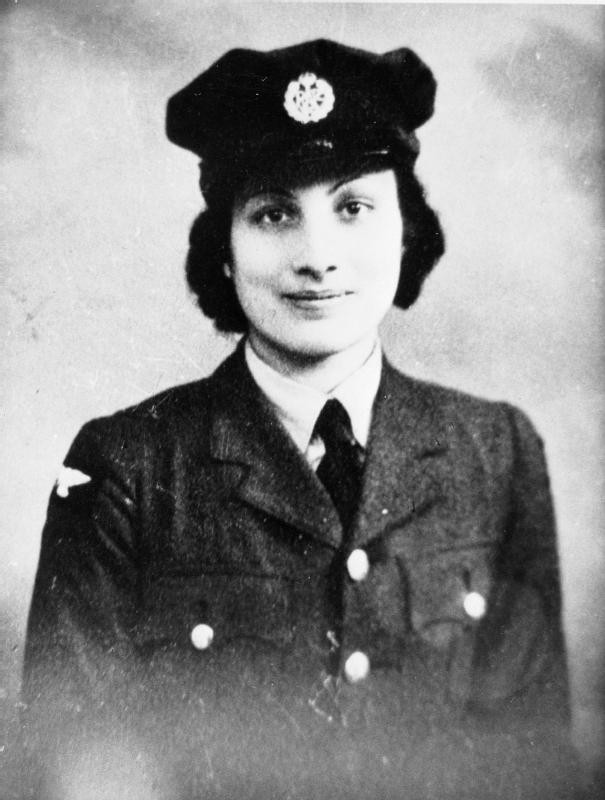
The Spy
When Nazi Germany invaded France in May 1940, Noor's family fled to London. Although pacifist ideals profoundly influenced Noor, she and her brother Vilayat decided to help defeat Nazi tyranny: "I wish some Indians would win high military distinction in this war. If one or two could do something in the Allied service, which was very brave and which everybody admired, it would help to make a bridge between the English people and the Indians."
In the UPF documentary "Enemy of the Reich," Noor's nephew Pir Zia-Inayat Khan summarized the circumstances that led her to join the British war effort. He said, "For Noor, the Second World War presented an existential challenge which became the overriding moment of truth as she faced the greatest evil in all of human history." She felt the need to face this challenge with the idealism she cherished all her life.
In November 1940, Noor joined the Women's Auxiliary Air Force (WAAF) and, as an Aircraftwoman 2nd Class, was sent to be trained as a wireless operator. Upon assignment to a bomber training school in June 1941, she applied for a commission she received in May 1942. She then went to Wiltshire for a specialist course in signal and wireless operation.
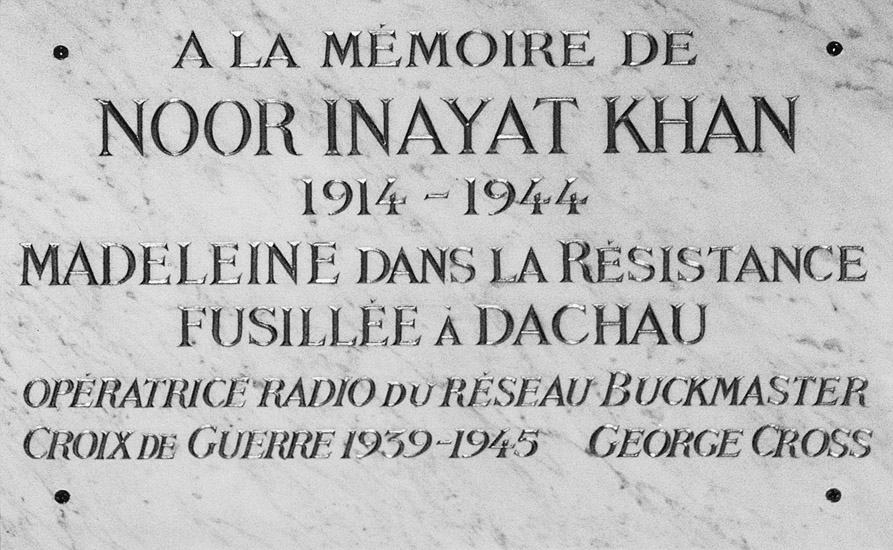
The British Government formed the SOE in July 1940 to carry out unconventional warfare against Germany. Its mission was to conduct espionage, sabotage, and reconnaissance in occupied Europe (and later, also in occupied Southeast Asia) against the Axis powers to aid local resistance movements. This secret organization recruited and trained agents who then infiltrated enemy-occupied countries to work with underground resistance movements. SOE's largest operation was in France, and it desperately needed more agents there.
Noor was an ideal candidate for any operation inside France because she was fluent in French and knew Paris well. The War Office considered her "almost perfect" for the work; she was "careful, tidy, and painstaking by nature." SOE offered her to work as a wireless operator and made her aware of the dangerous nature of the work involved and the high risk of capture and interrogation by the Gestapo. But Noor decided to take it up and requested to be posted in Paris, the most dangerous area of the SOE France operation. Until that point, women usually worked as couriers, and she was the first woman chosen for the role.
Noor's trainers were, however, not convinced of her abilities. They found her unsuitable for the task. She wouldn't lie, was eager to please, wouldn't deceive, and was too feminine. She excelled as a radio operator but performed poorly in coding secret messages, which often involved lies and deceit. She was unable to reconcile her Sufi idealism with the nature of the work. But Maurice Buckmaster, the Head of SOE France, could not afford to lose Noor as he badly needed more radio operators and asked his Chief Cryptologist Leo Marks to look into this.
Marks explored Noor's files and realized she was living in another world where self-sacrifice for others' wellbeing is of prime importance. He also realized that this idealism was a strength to be used and the key to making her a successful SOE agent. He explained to Noor that she would be doing what her Sufi idealism had taught her, saving lives and sacrificing for others by correctly coding secret messages as a part of her assignment. Noor's predicament was over.
In February 1943, Noor was posted to the Air Ministry Directorate of Intelligence and sent for further training such as explosives, small arms, and field security, involving lessons in avoiding detection and capture in the enemy-occupied territory and mock Gestapo interrogation. For the mission, she carried a kit of pills; pills for the enemy that induced six hours of sleep, stimulants to keep her awake and working, pills to produce stomach disorders, and finally, one pill with which to end her life.
The idealist Sufi was about to embark on a dangerous mission. The timeframe within which the Gestapo hunted down radio operators was just about six weeks. They needed less than 15 minutes to pinpoint an on-air radio location, meaning the operator must stop within 5 minutes, move with the bulky equipment elsewhere, and set up the 40ft aerial again.
But that didn't deter the Princess.
The Sufi Spy in Action
Unbeknownst to London, the Prosper network was already compromised. There was a double agent hidden inside the network. Within days of her arrival in France, the Germans started swooping down on all British agents. But Noor escaped. She was on the run all over Paris and its suburbs, continuing sending out messages to London at significant risk to her safety. It was a tiring and harrowing exercise, running from one place to another with the bulky wireless equipment, setting it up, before quickly putting it back to a suitcase and moving on. After months of being on the run, she was exhausted and sought refuge at a family friend, only to be betrayed by a close ally. It was Renée Garry who informed the Germans of Noor's whereabouts. Renée was the sister of Emile, the head of the Prosper network for which Noor worked. The Gestapo moved immediately, swooping her up on October 13, 1943. The reason for Renée's betrayal was not known, although the financial reward was a potential incentive. Then began the final battle between her Sufi idealism and Nazi brutality.
The Battle between Idealism and Brutality
Noor faced German interrogation at 84 Avenue Foch, the HQ of Sicherheitsdienst, the German Secret Service (SD) in Paris, but withstood it. She didn't lie, only refused to divulge any information. Despite the demoralizing and horrific conditions of her captivity, Noor remained steadfast and managed to escape on November 25. However, the guards, alerted by an RAF air raid, captured her again within a few hours. The Germans believed she would be continually trying to escape and wasn't likely to offer any information. On November 27, they sent her to Pforzheim prison for solitary confinement, classifying her as "Nacht und Nebel" or "Night and Fog."
"Nacht und Nebel" was the codename given to a decree of December 7, 1941, issued by Adolf Hitler and signed by Field Marshal Wilhelm Keitel, Chief of the German Armed Forces High Command. It allowed German authorities to abduct individuals alleged to be "endangering German security" so that they effectively vanished without a trace. The code name stemmed from Germany's most acclaimed poet and playwright, Johann Wolfgang von Goethe (1749-1832), who used the phrase to describe clandestine actions often concealed by fog and the darkness of night.
Shackled in chains most of the time and held in appalling confinement conditions, Noor still refused to yield. She cried in despair, scratching her identity and London address on the floor. On September 12, 1944, the Germans transferred Noor and three other women to the Dachau concentration camp, where they met their final destiny.
Can Idealism Effectively Fight Brute Force?
In the case of Noor, the answer was yes. Various sources confirmed that the Gestapo interrogation, torture, and the dehumanizing conditions of her captivity couldn't break her. On the other hand, most others captured at the time quickly collapsed and gave away valuable information. Idealism was, without doubt, the very reason why she joined the war effort and declined to return to London when all other agents were in German hands. In personal memoirs, Noor had written, most likely during her SOE training days, about the "joy of sacrifice" and how shooting a pistol helps "concentration and meditation." These words indicate how Sufi idealism strengthened her resolve. What kept her going till the very end, we can never tell for sure. One thing was for sure, though; her courage and bravery did create an impression on the German people. There is a plaque in Noor Inayat Khan's memory in the Memorial Hall at Dachau Concentration Camp.
Noor Inayat Khan Timeline
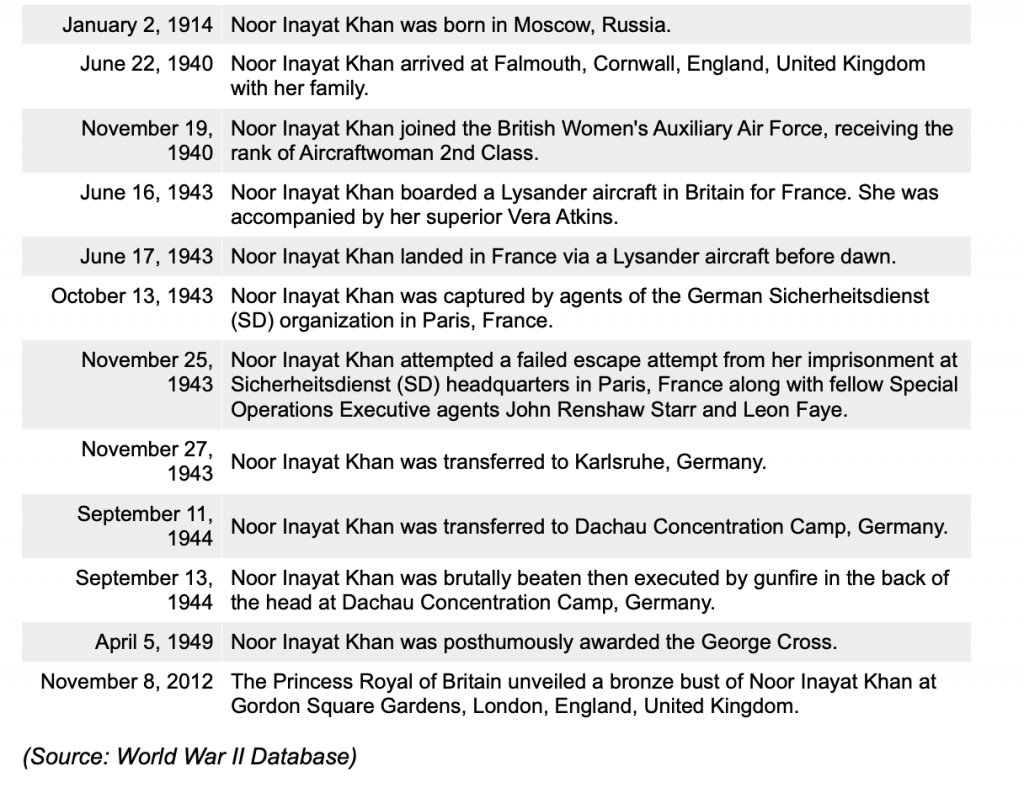
Photographs All photos are taken from the Noor Inayat Khan Memorial Trust website unless stated otherwise.
Reference
- "A Tribute to the Illuminated Woman of World War II," a poem by Irfanulla Shariff "Enemy of the Reich," a documentary film produced by Unity Productions Foundation (https://www.upf.tv/films/enemy-of-the-reich/watch)
- Noor Inayat Khan Memorial Trust Website (https://www.noormemorial.org/index.php) Visram, Rozina (1986).
- "Ayahs, Lascars and Princes: The Story of Indians in Britain 1700–1947." ISBN 9781138921214, Published December 7, 2016, by Routledge (https://www.routledge.com/Ayahs-Lascars-and-Princes-The-Story-of-Indians-in-Britain-1700-1947/Visram/p/book/9781138921214)
- World War II Database (https://ww2db.com/person_bio.php?person_id=861)
- this post on enblog internet archive